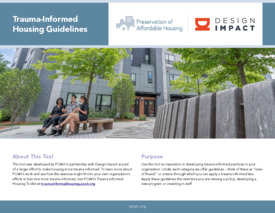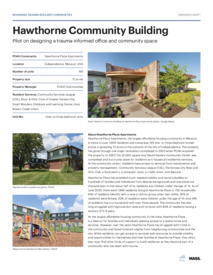- Simple and clear. Make rules and policies that residents and frontline staff find clear, concrete, and easy to understand and explain.
- Positive over punitive. Identify what people are allowed to do instead of not allowed to do.
- Accessible language. Make policies easy-to-understand for people with low English literacy (e.g. incorporate visuals, translate into multiple languages, write at a 3rd-grade reading level).
- Reinforce safety. Ensure rule or policy reinforces physical, mental, or emotional safety.
- Offer choice. Create rules and policies that offer choices and multiple options to residents and staff.
- Get feedback first. Get feedback from residents and staff before finalizing policy or rule.
- Create slack. Look for opportunities to loosen unnecessary or overly burdensome requirements.
Case Studies
- Go where the people are. Organize around what residents are already interested in.
- Center and include residents. Respond to their feedback accordingly.
- No failures, just learnings. Don’t take it personally if something isn’t working. What can you learn? What should change?
- Cultivate resident leadership. Create platforms where residents can contribute ideas. This takes trust, confidence, relationships.
- Work with your leaders’ strengths. Leverage what they’re already good at and passionate about.
- Show people you value them. Compensate and affirm leaders.
- Extend grace to residents (and yourself). Life happens. If leaders need to take a break, assure them “we’ll be here” when they come back.
Case Studies
- Center and include residents. Consider how residents will receive the message, first. Where possible, ask residents for feedback.
- Simple and clear. Avoid wordy or overly formal language.
- Positive over punitive. Identify what is possible, not just what is prohibited.
- Practice transparency. You won’t always have the answer or solution. Offer context for decisions and communicate next steps.
- Communicate with kindness. Use language and tone that speak to, not at, residents. Avoid any language that may be interpreted as insulting or demeaning.
- Practice inclusion. Ask, does this information include different cultures, races and religions?
- Consider barriers. Is this information easy to access and understand if English is not the resident’s first language? If the resident cannot read or write? If the resident has unreliable internet or is not tech savvy? If the resident cannot leave their home?
- Encourage mutual exchange. Look for ways to support staff and residents in better understanding each other’s perspective.
Case Studies
-
Start with self-awareness. Recognize your own triggers, stress and coping mechanisms. Acknowledge your own need for care.
-
Prioritize self-care. Model self-care through healthy boundaries and work/life balance or by offering incentives for staff.
-
Invest in organizational care. Dedicate time, money and energy into resources like flex time, social programs and wellness benefits.
-
Offer choice. Let staff choose options that work best for them, including voluntary participation in wellness activities. Avoid “one-size-fits-all.”
-
Treat staff experience as expertise. Ask for their feedback when implementing new projects or problem solving. Trusting staff is a form of caring for them.
-
Where possible, reduce workload. This work is demanding. Look for ways to reduce workload and add capacity.
-
Celebrate. Be generous with positive feedback. Celebrate staff accomplishments, however large or small.
Case Studies
- Treat the design process as part of the outcome. Embrace the principles of trauma-informed housing in the building design process.
- Be flexible. Projects are often underway before the community has a chance to weigh in. Create room for flexibility in the design process. Evolve as more community input is received.
- Safety is fundamental. Seek to understand what safety means to the community you serve, then offer a variety of space sizes, use quality materials, respect privacy and acoustics and promote equitable and inclusive access to spaces.
- Offer choice. Offer a variety of design features that allow individuals to make choices aligned with their needs, to feel heard and represented, and to practice self-care.
- Share power and decision-making. Embrace transparency in the design process, such as through participatory budgeting workshops or other shared decision-making exercises.
Case Studies
-
Case Study Hawthorne Community Building




